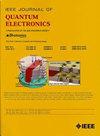Photo-Enhanced Room Temperature Magnetism and Two-Photon Effects in Manganese-Implanted Gallium Nitride p-i-n Structures
IF 2.2
3区 工程技术
Q3 ENGINEERING, ELECTRICAL & ELECTRONIC
引用次数: 0
Abstract
The insertion of manganese into GaN-based p-i-n epitaxial structures allows for a ferromagnetic phase to occur at room temperature that can be photo-enhanced and retained for >8 hours. GaN p-i-n LED structures are implanted with manganese to form a ferromagnetic phase and illuminated with resonant photons across the GaN bandgap. The magnetization after illumination is found to increase by锰植入氮化镓 pi-n 结构中的光增强室温磁性和双光子效应
在基于氮化镓的 pi-n 外延结构中植入锰,可在室温下形成铁磁相,这种铁磁相可被光增强并保持 8 小时以上。在 GaN pi-n LED 结构中植入锰以形成铁磁相,并用跨 GaN 带隙的谐振光子进行照明。发现照明后的磁化率增加了 0.2~\mu _{B}$ /锰原子。随后在氮化镓:锰带隙以下进行光照,可消除光增强磁性并使材料完全消磁。这一光学驱动过程证实,光子吸收驱动了 GaN:Mn 结构顶层的空穴介质诱导铁磁变化。为了改善空穴注入效应,我们设计了一种改进的 pi-n 结构,将二维空穴气体(2DHG)置于磁层之下。在 GaN:Mn 中植入锰形成的中隙态被模拟为双光子电磁诱导透明,它可以控制顶层的吸收并缓和空穴注入。探讨了 GaN:Mn pi-n 结构的自旋光子映射态设计,以用于存储器系统的长期存储。
本文章由计算机程序翻译,如有差异,请以英文原文为准。
求助全文
约1分钟内获得全文
求助全文
来源期刊

IEEE Journal of Quantum Electronics
工程技术-工程:电子与电气
CiteScore
4.70
自引率
4.00%
发文量
99
审稿时长
3.0 months
期刊介绍:
The IEEE Journal of Quantum Electronics is dedicated to the publication of manuscripts reporting novel experimental or theoretical results in the broad field of the science and technology of quantum electronics. The Journal comprises original contributions, both regular papers and letters, describing significant advances in the understanding of quantum electronics phenomena or the demonstration of new devices, systems, or applications. Manuscripts reporting new developments in systems and applications must emphasize quantum electronics principles or devices. The scope of JQE encompasses the generation, propagation, detection, and application of coherent electromagnetic radiation having wavelengths below one millimeter (i.e., in the submillimeter, infrared, visible, ultraviolet, etc., regions). Whether the focus of a manuscript is a quantum-electronic device or phenomenon, the critical factor in the editorial review of a manuscript is the potential impact of the results presented on continuing research in the field or on advancing the technological base of quantum electronics.
 求助内容:
求助内容: 应助结果提醒方式:
应助结果提醒方式:


